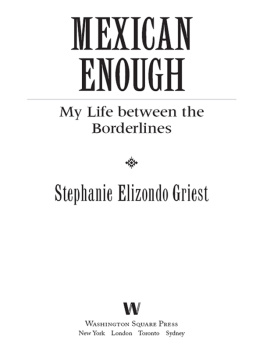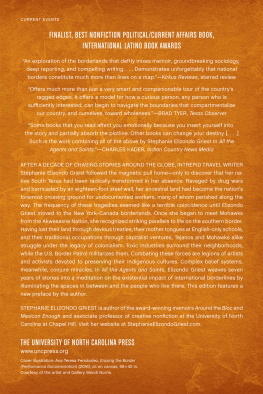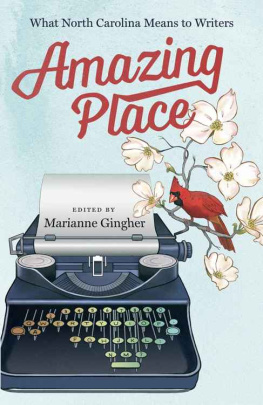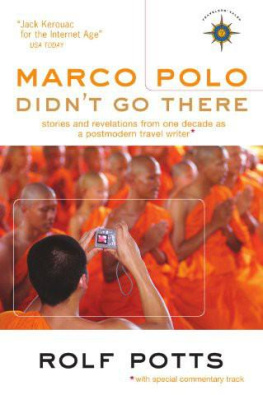All the Agents and Saints
ALSO BY STEPHANIE ELIZONDO GRIEST
Around the Bloc: My Life in Moscow, Beijing, and Havana
100 Places Every Woman Should Go
Mexican Enough: My Life Between the Borderlines
Best Womens Travel Writing 2010 (editor)
This book was published with the assistance of the Anniversary Fund of the University of North Carolina Press.
2017 Stephanie Elizondo Griest
All rights reserved
Manufactured in the United States of America
The University of North Carolina Press has been a member of the Green Press Initiative since 2003.
Cover illustration: Ana Teresa Fernndez, Erasing the Border (Performance Documentation) (2016), oil on canvas, 68 42 in. Courtesy of the artist and Gallery Wendi Norris.
LIBRARY OF CONGRESS CATALOGING-IN-PUBLICATION DATA
Names: Elizondo Griest, Stephanie, 1974 author.
Title: All the agents and saints : dispatches from the U.S. borderlands / Stephanie Elizondo Griest.
Description: Chapel Hill : The University of North Carolina Press, [2017] Identifiers: LCCN 2016047328 | ISBN 9781469631592 (cloth : alk. paper) | ISBN 9781469631608 (ebook)
Subjects: LCSH: Mexican AmericansTexas. | Mohawk IndiansNew York (State) | Mexican-American Border Region. | Canadian-American Border Region.
Classification: LCC F395.M5 E45 2017 | DDC 972/.1dc23
LC record available at https://lccn.loc.gov/2016047328
Portions of chapters 1, 2, 4, 7, 8, and 18 were originally published, respectively, in Sangam House Reader, vol. 3 (New York: Sangam House, 2015); the Dallas Morning News, September 12, 2010; Earth Island Journal, Spring 2012, 3843; Oxford American, Spring 2015, 6275; Oxford American, Fall 2013, 3537; and The Best Travel Writing, Volume 10 (Palo Alto, Calif.: Travelers Tales, 2015), 12028; and Witness, Winter 2014, http://witness.blackmountaininstitute.org/issues/volume-27-number-3-winter-2014/three-nations-crossing/.
FOR MY HOMELAND, CORPITOS
Contents
Maps
U.S.-Mexican border
U.S.-Canadian border
Akwesasne, at the U.S.-Canadian border
Introduction: The Descendants
WE ALL KNOW THE RULES. CROSS AN INTERNATIONAL BORDERLINE without the proper papers andunless luck or privilege protects youget arrested, imprisoned, and expelled. But what happens when an international borderline crosses over you, slicing your ancestral land in two? Division-by-force has been the confusing fate of peoples the world over. This book explores its living legacy among two: the Akwesasne Mohawks, whose territory was split between Canada and the United States by a series of treaties signed between 1783 and 1850, and the Tejanos of South Texas, who were severed from their native Mexico by the Treaty of Guadalupe-Hidalgo in 1848.
Were I not myself a Tejana who had recently spent a year near Akwesasne, I would find this pairing odd. More than 2,000 miles stand between our communities, andwith the exception of Catholicismour cultures hold little of that ground in common. Mohawks traditionally subsisted on hunting, farming, and fishing in one of the coldest regions of the United States, whereas my forefathers tended cattle in one of the hottest. They are matriarchal; we tend toward machismo. We are fanatical about football; Mohawks dont just revere lacrosse, they invented it.
We also experience our respective borders quite differently. Many Mohawks refuse to acknowledge the lines at all. They are a sovereign people who employ their own police force and operate their own library, museum, media, school, and court. They look not to Washington or Ottawa for governance but to the Haudenosaunee (Iroquois) Confederacy, of which they have been members for centuries. Many vote in tribal elections but not federal, state, or provincial ones because they view those systems as foreign (and even hostile) to their own. I know one Mohawk who regularly switches residency from one side of the border to the other whenever one government happens to offer better benefits, but most live near the homesteads their families have held for generations.
Yet because Akwesasnes (recognized) territory spans just 26,350 acres along land also governed by New York, Ontario, and Quebec, its citizens are profoundly affected by the borderlines in their midst. Many must contend with Customs and Border Patrol agents multiple times a day: to get to work, to take their children to school, to grab a Dunkaccino, to attend a Longhouse ceremony or Mass. I have yet to meet the Mohawk whom this does not enrage. Protests are frequent at Akwesasne, as are bridge closures and other acts of civil disobedience.
Most Tejanos I know resent the obstructions in our roadways, too. However, the only time Ive seen us demonstrate was when Congress decided to build a border wall that carved up our neighborhoods. Many of us view the wall not as a safeguard to homeland security but as yet another threat to our once-thriving binational community. Not so long ago, we crossed the borderline all the time. Our in-laws lived in Matamoros; our clients were in Reynosa; our dentist was in Progreso. Our tas could get their hair and nails done for the price of a blow-out in McAllen. And who could resist a salt-rimmed margarita at the Cadillac Bar?
Then in 2006, Mexican president Felipe Caldern declared war on the drug cartels, sparking retaliations that claimed upward of 10,000 lives a year. As reports of beheadings began to top the local news hour, many Tejanos who could shift their activities northward did so. Besides a few journalists and activists, no one I know ventures south to the border towns anymoremy family included. Fear has constructed a wall far taller than what Congress envisioned.
This raises another key difference between Akwesasne Mohawks and the Tejanos of South Texas. Akwesasne is largely self-contained. There is no better place for Mohawks to learn their robust language, traditions, and ceremonies than right inside their nation. Indeed, Akwesasne is one of the only places where such is even possible. Tejanos also boast a vibrant culture that includes a world-famous cuisine (Tex-Mex) and a pop goddess (Selena). Yet the nostalgic among us feel that the only place to truly grasp our heritage is in Mexico, even if we no longer have family there. Having historically been treated as outsiders by whites and as traitors (or worse: strangers) by Mexican nationals, we have a visceral desire to know what inside us is Mexican, what is gringo, and by what alchemy our ancestors fused the two.
For Mohawks, then, the borderline is mostly a physical obstruction that insults their sovereignty. For Tejanos, it is more of a psychic block that stifles our connectivity.
But the purpose of this book is not to spotlight the differences in our communities. Those are readily apparent. No, what startled me about Akwesasne was how often I experienced dj vu there. Practically every major story Id heard in half a lifetime in South Texas was echoed at some point that year at Akwesasne. Whether the issue was environmental degradation, language loss, drug trafficking, the diabetes epidemic, or confrontations with the Border Patrol, our communities not only had endured the same struggles but had shared similar methods of transcendence as well. Activists heeded the cries unheard by federal or social services, while artists elevated the spirits. Mexican patron saint La Virgen de Guadalupe and Mohawk saint Kateri Tekakwitha appeared right when her respective believers needed her most.
Much too often we hear about the U.S. borderlands only from the politicians who dictate their policies from afar. Rarely do we learn from the descendants of the regions early inhabitants. Starting first with the Tejanos of South Texas and then moving on to the Mohawks of Akwesasne, I align their stories side by side as a
Next page





